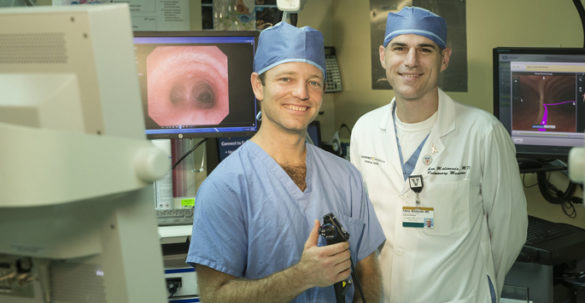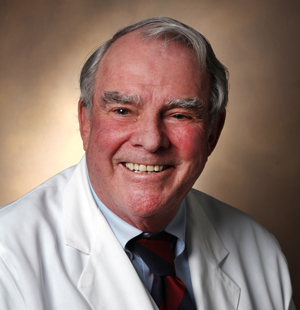Fabien Maldonado, M.D., recently joined the Division of Pulmonology, bringing with him expertise in minimally invasive medical pleuroscopy that he honed during his nine years at the Mayo Clinic.

Although he joined Vanderbilt a year ago, he only recently received credentialing to offer a fairly new procedure that expands the field of interventional pulmonology to diagnose and treat pleural diseases such as cancer and mesothelioma.
There are 1.5 million new pleural effusions diagnosed every year in the United States, with 150,000 to 200,000 being malignant. Pleural effusion is an accumulation of extra fluid in the pleural space, which is the space between the lungs and the chest wall. More than 75 percent of people with a malignant pleural effusion have lymphoma or cancers of the lung, breast or ovary, among others.
Medical pleuroscopy is a minimally invasive outpatient procedure that uses an instrument similar to a flexible bronchoscope, but shorter in length. Maldonado inserts the pleuroscope (a thin tube-like scope equipped with a camera) through a single small incision in the chest wall to visualize the pleural cavity. Doing so allows him to obtain pleural tissue samples, drain excess fluid around the lungs and occasionally perform pleurodesis or place an indwelling pleural catheter.
With minimal medication, the procedure is extremely well tolerated by patients, Maldonado said.
“We remove fluid and take a look at the pleural cavity and conduct targeted biopsies of pleura. With a diagnostic yield of 90-95 percent, we are also able to collect a lot of samples for ancillary testing,” he said.
Pleuroscopy is an alternative approach to surgery for the diagnosis of unexplained pleural effusions, and can be performed safely on an outpatient basis, as demonstrated in a study he published two years ago while at the Mayo Clinic. It is less invasive than surgery, which typically requires general anesthesia and a hospital stay, but associated with a much better yield than thoracentesis (only 60 percent in malignant pleural effusions).
“The most important diagnosis is that of cancer. If we find cancer cells in the fluid, we know what we’re dealing with. If we don’t, which happens in 25 to 40 percent of patients, that doesn’t mean anything. Choosing to observe a patient after a negative thoracentesis will leave many patients with undiagnosed malignant pleural effusions, and a window of opportunity for early treatment may be lost,” Maldonado said.
“The landscape of cancer therapeutics has changed dramatically in the last decade. Novel treatments, such as targeted therapy and immunotherapy, can be very effective even in advanced stage disease. So, there are compelling reasons to make the diagnosis sooner now.”
Pleuroscopy is not yet extensively used in the United States, but its use will increase as the interventional pulmonology subspecialty gains traction and importance, Maldonado said.
Maldonado received his M.D. from the University of Burgundy, France, in 2002. He trained in Internal Medicine at Western Reserve Care System in Northeast Ohio, completed a Pulmonary and Critical Care Fellowship at Mayo Clinic and an Interventional Pulmonary fellowship at the Université de la Méditerranée in Marseilles, France, in 2010. He was on faculty at Mayo Clinic for 5 years before moving to Nashville in July 2015. His research interests include quantitative imaging on computed tomography for lung cancer, novel minimally invasive diagnostic techniques for lung cancer and pleural diseases. He is also involved in many educational efforts in the field of Interventional Pulmonology.















